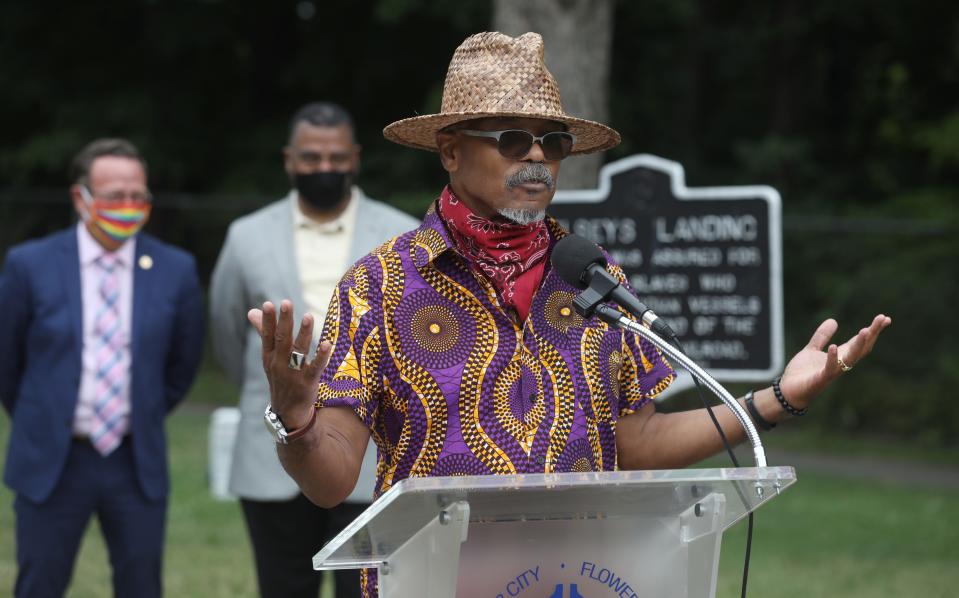New Frederick Douglass statue erected after vandalism with hopes for a better future for all
ROCHESTER, N.Y. - At the site where escaped, enslaved people once boarded ships to make their way to Canada and freedom, the present met the past on Thursday — with hopes that the future will be impacted.
A new statue of abolitionist Frederick Douglass was erected at the Kelsey's Landing site at Maplewood Park in Rochester, the location where Douglass, Harriet Tubman and others shuttled former slaves who had navigated the Underground Railroad en route to Canada. This statue replaced one that was toppled over on July 5.
"Can you only imagine what it took to get here if you were an enslaved person?" said Carvin Eison, who heads the committee that two years ago erected Douglass statues across Rochester. "What it must have felt like. Can you imagine how many good and kind people must have helped along the way?"
Then, the most pressing question, Eison said: "Would you have been one of those people?"
Douglass statue: In 2018, they vandalized a Frederick Douglass statue. Now they'll help install a new one.

The quick response to the damage of the Douglass statue shows that his message of tolerance and acceptance and racial equality are still as relevant today as they were during his lifetime, Eison and other speakers said Thursday at the installation of the statue. With the country focused on the legacy of racism, the words and life of Douglass can provide a touchstone and a path for moving forward, they said.
"It's time to answer the call of history and the message of Frederick Douglass is showing us how," said City Council Vice-President Willie Lightfoot.
Sculptor Olivia Kim said the statue project was an example of people from all backgrounds working together.
"Over 200 volunteers helped me make 13 statues in only 6½ months," she said about the 2018 project, which was overseen by the Re-Energizing the Legacy of Frederick Douglass Committee. The committee has also launched a fundraising campaign for money for the maintenance of the Douglass statues in Rochester.
Whenever a certain tool or specialty was needed with the project, a volunteer seemed to walk into the door with the answer "within minutes," Kim said. That fortuity became known to her and the volunteers as "the Freddie miracle."
The recent vandalism, she said, was difficult, especially since another statue was destroyed in 2018.
"The vandalism is very painful," she said. "Please, do not allow the pain to tear us apart."
Statue toppled: Frederick Douglass statue in New York vandalized on anniversary weekend of 'What to the Slave is the Fourth of July' speech
Eison said he, too, was pained at the news another statue was damaged. But, he said, the aftermath was heartening. He received calls from across the country, with offers to help the Douglass committee in any way possible.
One of those calls came from former Rochesterian Dr. John Lipman, who is the founder and medical director of the Atlanta Fibroid Center. Lipman, having learned of the vandalism, donated $10,000, which the Douglass committee is using as a kick-off for a fundraising campaign for statue maintenance.
In a telephone interview Thursday, Lipman said he grew up near Highland Park, where a Douglass statue was once prominently located. He likened the historical legacy of Douglass and Rochester with that of the connections between the Rev. Martin Luther King Jr. and Atlanta, where Lipman now lives.
The Douglass statue "symbolizes racial equality, human rights, everything that is important," Lipman said.
Days before he learned of the destruction, Lipman posted on his Instagram page words from Douglass' famous July 5, 1852 speech at Corinthian Hall in Rochester. There, Douglass challenged the concept of July 4 as Independence Day, with so many people then brutally enslaved in the country.
As Lipman wrote, and Douglas said: "What have I, or those I represent, to do with your national independence?
"Are the great principles of political freedom and of natural justice, embodied in that Declaration of Independence, extended to us? and am I, therefore, called upon to bring our humble offering to the national altar, and to confess the benefits and express devout gratitude for the blessings resulting from your independence to us?"
"I found out a couple of days later that vandals had pulled down his statue and I was horrified," Lipman said.
On Thursday, Eisen remembered a saying, "When the student is ready, the teacher will come."
"And nearly 130 years after his death the teacher, in the form of Frederick Douglass, still comes to teach us all," Eison said, "if we as students are ready to learn."
Follow Gary Craig on Twitter at gcraig1.
This article originally appeared on Rochester Democrat and Chronicle: New Frederick Douglass statue erected in New York after vandalism

